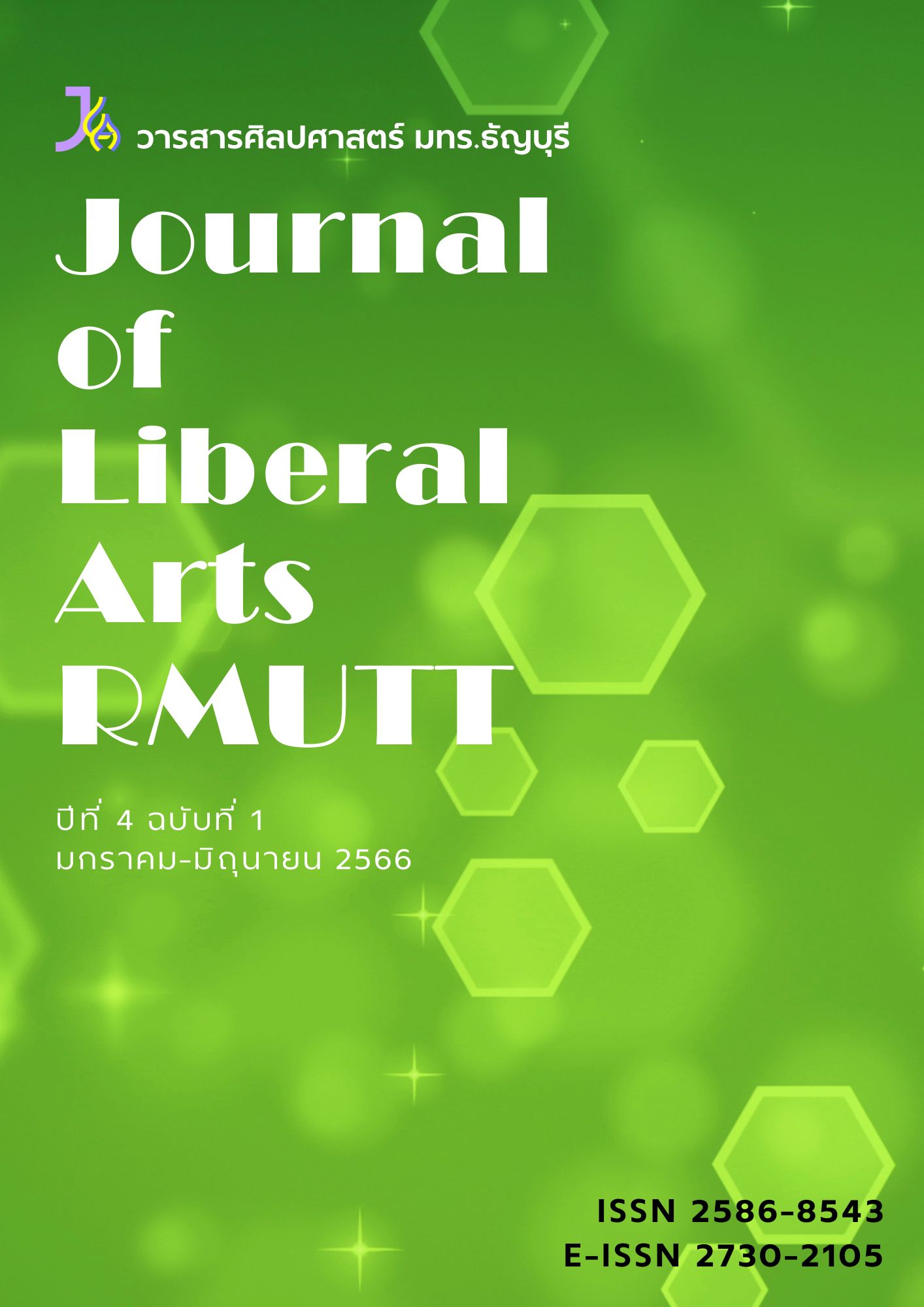คำที่ใช้แสดงความเหมือนและความแตกต่างในข่าวธุรกิจ
คำสำคัญ:
คำแสดงความเหมือน , คำแสดงความต่าง , บทความข่าวธุรกิจบทคัดย่อ
งานวิจัยนี้ศึกษาการใช้คำแสดงความเหมือนและความต่างในข่าวธุรกิจ งานวิจัยที่เกี่ยวข้องกับการศึกษาการใช้คำแสดงความเหมือนและความต่างในงานวิจัยก่อนหน้านี้ให้ความสำคัญกับงานเขียนของนักเรียนที่เรียนภาษาอังกฤษเป็นภาษาต่างประเทศ เช่น นักศึกษาญี่ปุ่น นักศึกษาอินโดนีเซีย และนักศึกษาไทย และตัวบทความวิจัยภาษาศาสตร์ประยุกต์ อย่างไรก็ตาม งานวิจัยครั้งนี้เลือกตัวบทที่แตกต่างออกไป คือ ข่าวธุรกิจ ชุดข้อมูลเก็บรวบรวมมาจากคอลัมส์ธุรกิจในหนังสือพิมพ์รายวัน The New York Times ซึ่งเป็นหนังสือพิมพ์อเมริกันที่มีผู้อ่านมากที่สุด ชุดข้อมูลหนังสือพิมพ์ข่าวธุรกิจได้เก็บรวบรวมระหว่างวันที่ 1 มกราคม 2566 ถึงวันที่ 28 กุมภาพันธ์ 2566 คำ จำนวนทั้งสิ้นประมาณ 120,000 คำ ประกอบด้วย 280 ตัวอย่าง การใช้คำแสดงความเหมือนและความต่างในข่าวธุรกิจ การวิเคราะห์การใช้คำแสดงความเหมือนและความต่างดำเนินการตามแบบของ Swan (2016) เพื่อให้การวิเคราะห์ข้อมูลดำเนินการไปอย่างถูกต้องและเหมาะสม นักภาษาศาสตร์ผู้ใช้ภาษาอังกฤษเป็นภาษาแม่ จำนวน 3 ท่าน มาดำเนินการตรวจสอบการวิเคราะห์ความเที่ยงระหว่างผู้ประเมิน และความเที่ยงตรงของเนื้อหา ผลการศึกษาแสดงให้เห็นว่า การใช้คำแสดงความเหมือนและความต่างในข่าวธุรกิจถูกใช้เป็นจำนวนร้อยละ 59.29 และ 40.71 ตามลำดับ ปรากฎการณ์นี้สามารถอธิบายได้โดยความไม่เป็นทางการ (principle of informality) การแสดงความคิดเห็นเชิงขัดแย้ง (subjectivity) และการให้ข้อมูลโดยใช้คำตรงกันข้าม (antonym) นักวิจัยหวังเป็นอย่างยิ่งว่าผลการศึกษาครั้งนี้จะเป็นประโยชน์ต่อผู้เรียนภาษาอังกฤษเป็นภาษาต่างประเทศในเชิงการใช้คำแสดงความเหมือนและความต่างเพื่อการเขียนเชิงธุรกิจได้อย่างถูกต้องและเหมาะสม
เอกสารอ้างอิง
Almusharraf, N., & Alotaibi, H. (2023). An error-analysis study from an EFL writing context: Human and Automated Essay Scoring Approaches. Technology, Knowledge and Learning, 28(3), 1015-1031.
Bearak, M. (2023). Inside the global race to turn water into fuel. The New Yorks Times. 7. Retrieved from https://www.nytimes.com/2023/03/11/climate/green-hydrogen-energy.html
Dirven, R., & Radden, G. (2007). Cognitive English grammar. Amsterdam: John Benjamins.
Gelbukh, A. & Kolesnikova, O. (2012). Semantic analysis of verbal collocations with lexical function. New York: springer.
Hamed, M. (2014). Conjunctions in argumentative writing of Libyan tertiary students. English Language Teaching, 7(3), 108-120.
Hinkel, E. (2012). Teaching academic ESL writing: Practical techniques in vocabulary and grammar. New York: Routledge.
Halliday, M. A. K., & Hasan, R. (1989). Language, context and text: aspects of language and meaning. London: Edward Arnold.
Hylang, K. & Jiang, F. (2017). IS academic writing becoming more informal?. Journal of English for Specific Purposes, 45, 40-51.
Maheshwari, S. & Mccabe, D. (2023). Finding a buyer for TikTok may not be so easy. The New Yorks Times, 6.
Retrieved from https://www.nytimes.com/2023/03/16/business/media/tiktok-buyer-biden.html
Martin, P. (2010). The Wall Street Journal Guide to Business Style and Us. New York: Simon and Schuster.
Mittal, R. (2014). Role of newspaper in English language learning. International Journal of Research (UR), 1(6), 689-693.
Narita, M., Sato, C., & Sugiura, M. (2004). Connector usage in the English essay writing of Japanese EFL Learners. LREC, 27(1). 1171-1174.
Oshima, A., & Hogue, A. (2006). Writing academic English. USA: Pearson Longman.
Soleimani, H., & Najafgholian, S. (2014). The relationship between creativity in thinking and writing performance of Iranian EFL learners on comparison/contrast. International Journal of English Language and Literature Studies, 3(3), 223-233.
Santangelo, T. (2014). Why is writing so difficult for students with learning disabilities? A narrative review to inform the design of effective instruction. Learning Disabilities: A Contemporary Journal, 12(1), 5-20.
Seo, Y., & Kim, C. (2020). The use of short fiction in a rriting Class: Pedagogical suggestions for secondary level teachers in EFL settings. English Teaching, 75(1), 119-139.
Swan, M. (2016). Practical English grammar. Oxford: Oxford University Press.
Toba, R., Noor, W. N., & Sanu, L. (2019). The current issues of Indonesian EFL students’ writing skills: Ability, problem, and reason in writing comparison and contrast essay. Dinamika Ilmu, 19(1), 57-73.
Watcharapunyawong, S. & Usaha, S. (2013). Thai EFL students’ writing in different text types: The interference of the first language, 6(1), 67-78.
Wongkittiporn, A. (2022). Semantic interpretations of passive constructions in business news articles. Journal of Language, Religion and Culture, 11(2), 1-29.
ดาวน์โหลด
เผยแพร่แล้ว
รูปแบบการอ้างอิง
ฉบับ
ประเภทบทความ
สัญญาอนุญาต
ลิขสิทธิ์ (c) 2023 วารสารศิลปศาสตร์ มทร.ธัญบุรี

อนุญาตภายใต้เงื่อนไข Creative Commons Attribution-NonCommercial-NoDerivatives 4.0 International License.









